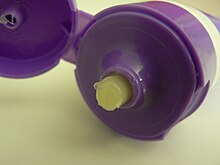Lanolin: Difference between revisions
No edit summary |
|||
| Line 1: | Line 1: | ||
'''Lanolin''', also called '''Adeps Lanae''', '''wool wax''', '''wool fat''', '''anhydrous wool fat''' or '''wool grease''', is a greasy yellow substance secreted by the [[sebaceous gland]]s of [[wool]]-bearing animals such as [[sheep]]. Chemically akin to [[wax]], it can be used as a skin ointment or water-proofing wax, and is also sometimes used as a raw material in the manufacture of such products as [[shoe polish]]. Lanolin's ability to act as a waterproofing wax aids sheep in shedding [[water]] from their coats. Certain breeds of sheep produce large amounts of lanolin, and the extraction can be performed by squeezing the sheep's harvested wool between rollers. Most or all of the lanolin is removed from wool when it is processed into [[textiles]], such as [[yarn]] or [[felt]]. |
'''Lanolin''', ....also called '''Adeps Lanae''', '''wool wax''', '''wool fat''', '''anhydrous wool fat''' or '''wool grease''', is a greasy yellow substance secreted by the [[sebaceous gland]]s of [[wool]]-bearing animals such as [[sheep]]. Chemically akin to [[wax]], it can be used as a skin ointment or water-proofing wax, and is also sometimes used as a raw material in the manufacture of such products as [[shoe polish]]. Lanolin's ability to act as a waterproofing wax aids sheep in shedding [[water]] from their coats. Certain breeds of sheep produce large amounts of lanolin, and the extraction can be performed by squeezing the sheep's harvested wool between rollers. Most or all of the lanolin is removed from wool when it is processed into [[textiles]], such as [[yarn]] or [[felt]]. |
||
==Chemical makeup== |
==Chemical makeup== |
||
Revision as of 12:25, 16 November 2008
Lanolin, ....also called Adeps Lanae, wool wax, wool fat, anhydrous wool fat or wool grease, is a greasy yellow substance secreted by the sebaceous glands of wool-bearing animals such as sheep. Chemically akin to wax, it can be used as a skin ointment or water-proofing wax, and is also sometimes used as a raw material in the manufacture of such products as shoe polish. Lanolin's ability to act as a waterproofing wax aids sheep in shedding water from their coats. Certain breeds of sheep produce large amounts of lanolin, and the extraction can be performed by squeezing the sheep's harvested wool between rollers. Most or all of the lanolin is removed from wool when it is processed into textiles, such as yarn or felt.
Chemical makeup
Chemically, lanolin is a wax, that is a mixture of esters of fatty acids with high molecular weight [alcohol]]s. There are more than 180 different acids and 80 alcohols identified. The melting point is about 40ºC. Insoluble in water but forms very stable emulsions with it. At one point, the name Lanolin was trademarked as the generic term for a preparation of sheep fat and water. [1]
Uses

Lanolin is used commercially in many products ranging from rust-preventative coatings to cosmetics to lubricants. Some sailors use lanolin to create a slippery surface on their propellers and stern gear to which barnacles cannot adhere. The water-repellent properties make it valuable as a lubricant grease where corrosion would otherwise be a problem, particularly on stainless steel, which becomes more vulnerable to corrosion when starved of oxygen.
Medical grade lanolin is used as a cream to soothe skin, as it is hypoallergenic and bacteriostatic. In this form it is used by some breastfeeding mothers on sore and cracked nipples. This grade of lanolin can also be used to treat chapped lips, diaper rash, dry skin, itchy skin, rough feet, minor cuts, minor burns and skin abrasions. Many varieties of shaving cream contain lanolin. As an ointment base, it is readily absorbed through skin, facilitating absorption of the medicinal chemicals it carries. Some folk medicine traditions use lanolin in the nose, in small amounts, to treat head colds.
Lanolin is often used by baseball players to soften and break in their gloves (shaving cream that contains lanolin is popularly used for this).
The name given to the product 'Oil of Olay' is derived from the word "lanolin," a key ingredient, which was chosen by the inventor, Graham Wulff.[2]
Using cosmetic products which contain impure lanolin can result in an allergic reaction in some people.
Lanolin is often used as a raw material for producing vitamin D3.
Anhydrous lanolin is also used as a lubricant for brass instrument tuning slides.
Production
Crude lanolin constitutes approximately 5-25% of the weight of freshly shorn wool. The wool from one Merino sheep will produce about 250-300 ml of recoverable wool grease. Lanolin is extracted from wool via a scouring process. This process involves washing the wool in hot water with a special wool scouring detergent to remove dirt, wool grease (crude lanolin), suint (sweat salts), and anything else stuck to the wool. The wool grease is continuously removed during this washing process by centrifugal separators, which concentrate the wool grease into a wax-like substance melting at approximately 38°C (100°F).
References
- ^ Jaffe v. Evans & Sons, Ltd., U.S. (Supreme Court, Appellate Division, First Department, New York March 21, 1902).
- ^ "History of Olay". Procter & Gamble.
Links
- Lanolene - Lanolin Coatings, Waxes, Protectants and Lubricants (lanolene.com)
- [1] Lanotec - Lanolin based alternatives to petro-chemical products
- Lansinoh - Lanolin ointment for Breastfeeding Mothers (Lansinoh.co.uk)
